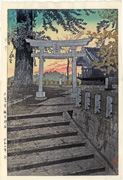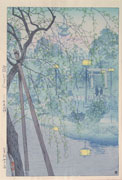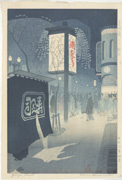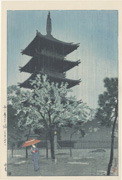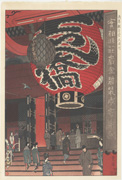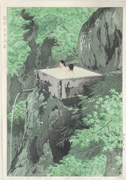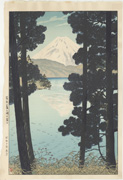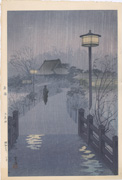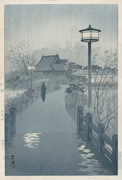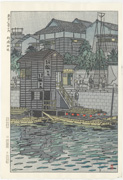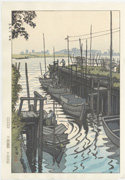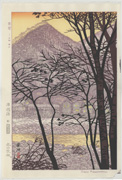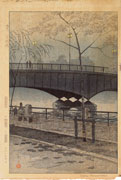| IHL Cat. #1189 | IHL Cat. #217 | IHL Cat. #25 |
IHL Cat. #1318 | |
Tea Ceremony, 1954 (undated, possibly 21st century edition) IHL Cat. #1178 |
| Near Yanagibashi, 1954 IHL Cat. #34 | Edo River at Imai, 1955 IHL Cat. #28 | Remaining Light at Jōshū, Minakami, 1958 IHL Cat. #1179 | Kototoi Bridge on the Sumida River, 1959 IHL Cat. #377 |
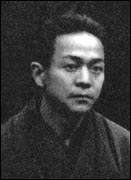 Shiro Kasamatsu (undated photo) | ProfileKasamatsu Shirō 笠松紫浪 (1898-1991) Source: Lawrence University website http://www.lawrence.edu/dept/wriston/collections/jwp/Shiro%20Kasamatsu.htm Kasamatsu Shirō was born in Tokyo and became a student of painting and printmaking in the school of Kaburaki Kiyokata (1878-1973) at the age of 13. In 1919, the publisher Watanabe Shōzaburō (1885-1962) saw the artist’s work and asked him to design woodblock prints. By the late 1940s Kasamatsu had created more than 50 prints commissioned and published by Watanabe. As with many other artists, his blocks were lost in the Great Kanto earthquake of 1923, when resulting fires destroyed Watanabe's print shop. In the early 1950s Kasamatsu changed his publishing partner to Unsōdō in Kyoto, creating 102 prints for him over an eight year period (1952-1960). These are nearly all in shin hanga style, showing traditional subjects such as landscapes and a few interiors. These prints insured a steady income, and allowed the artist to branch out with other work. At the same time as he was producing the shin hanga style work for Unsōdō, Kasamatsu started experimenting in |
Biography
Sources: Hanga.com website www.hanga.com http://www.hanga.com/bio.cfm?ID=3 and Printed to Perfection: Twentieth-century Japanese Prints from the Robert O. Muller Collection, Amy Reigle Newland, et. al., Hotei Publishing, 2004, p. 113.Born in the Asakusa section of Tokyo to a middle class family, Kasamatsu Shirō
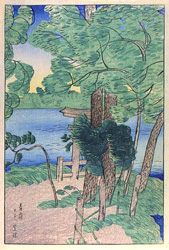
Shirō's paintings were shown at several prestigious exhibitions including the Kokumin Bijutsu Kyokai (The People's Art Society) and the government sponsored Bunten, Sengakai (The Select Art Society), where they caught the eye of Watanabe Shōzaburō (1885-1962), a Tokyo publisher. Shirō was also active in the Tatsumi Gakai (Southeast Painting Society), Seikinkai (Blue Collar Society) and Kyodokai (Homeland Society). In 1919, Watanabe approached Shirō about designing woodblock prints. No doubt Kiyokata facilitated this introduction as he had done for several other students, including Kawase Hasui (1883-1957) and Ito Shinsui (1898-1972). Shirō's first print, A Windy Day in Early Summer, 1919 (above), was published in that same year. He designed several landscape prints over the next few years, but the blocks for these were lost in the 1923 Great Kanto earthquake and they are quite rare.
Shirō resumed his work with Watanabe in the 1930's. His designs were mainly of landscapes, but also included bijin-ga, interiors, and Noh masks (one of his particular interests). Western collectors were especially attracted to his romantic landscapes depicting traditional Japanese life and landmarks. Hazy Evening at Shinobazu Pond, published in 1932, was so popular that it was continually reprinted throughout the 1930's and 1940's. It was published in several different color combinations, including an aizuri-e (blue) version. In this print and many others, Shirō used foreground elements like branches to draw in the viewer and give the image depth. This was a design technique first originated by the ukiyo-e artist Hiroshige.
In 1936, he was one of the artists included in the seminal print exhibition of shin hanga prints at the Toledo Museum of Art.
In 1939, Shirō designed the series Eight Views of Tokyo for Watanabe, but only four prints were completed. His relationship with Watanabe was nearing a close, probably because Watanabe did not give him the creative control that he desired, and he stopped working with Watanabe after WWII.
From 1952-1960, he collaborated with Unsōdō, a publisher in Kyoto, designing over 100 landscape and animal prints. Many of the prints published by Unsōdō are quite striking and compare favorably with the Watanabe-published prints.
Shirō was intrigued by the independence of sosaku hanga printmakers who carved and printed their own designs, but it would not be until the late 1950's that he was ready to break out on his own and begin carving and printing his own designs in limited, numbered editions. He signed these prints himself in English. (Some of his Watanabe-published prints also bear English signatures; however, these signatures were applied by Watanabe's employees, not by the artist himself.)
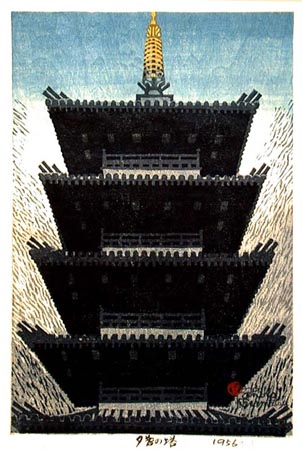
Shirō produced about 290 prints during his life.
Literature
Dr. Andreas Grund, Shiro Kasamatsu - The Complete Woodblock Prints, self-published by the author, Tokyo, 2001
Sample Signatures and Seals
紫浪
Shirō
with
Shirō saku seal紫浪
Shirō
with
Shirō seal紫浪
Shirō
with unread seal紫浪
Shirō
with Shirō seal紫浪
Shirō with Shirō seal紫浪
Shirō
with Shirō seal紫浪
Shirō
with Shi seal紫浪
Shirō
with unread seal
紫浪
Shirō
Shiro Kasamatsu with Shirō sealShiro Kasamatsu with unread seal
Shiro
Shirō seal
Shirō seal
かさまつ
Kasamatsu seal
紫浪
Shirō sealunread seal
紫浪
Shirō seal
紫浪
Shirō seal
